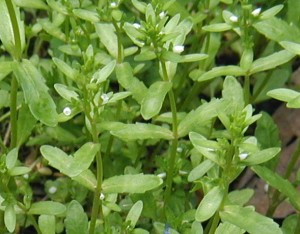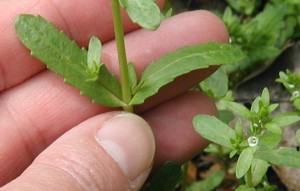Flowering plants number in the thousands or hundreds of thousands actually. Indeed, the huge variety of types of flowers is one thing that draws me to them…the seemingly infinite arrangement of colors, shapes and sizes.
Sometimes I find a flower that is more of a curiosity than anything else. Take for instance these tiny little flowers that come out in early spring. You can find them appearing in flower beds and walkways, along roads and in lawns.
To find out what these little plants are, you’d need a weed book, I guess. The flowers are so tiny as to disappear from view in a short distance. With blossoms that are 1-2 mm across, these posies won’t appear in a wildflower book for their flashyness. Not exactly eye-catching, unless you’re on the ground with them.
Those that we see in the lawn near the garden have a tiny blue flower with four petals. In the center of the blossom is a white ring that surrounds a couple of light-colored stamens. The flower looks like it belongs to the Speedwell group.
The plant has a sprawling habit as it sends out hairy, maroon runners in all directions. The broad, spade-shaped leaves along the runners are scalloped on the edges and lie opposite one another. Where the runners terminate, the leaves become less broad and they’re more tightly packed together. Flowers appear singly in the leaf axils. Photos taken 3 May 2011.


Right next to the tiny blue flowers were a bunch of tiny white flowers. These little curiosities appear in the lawn each spring.
The tiny white flowers seem to be a form of speedwell also, with opposite leaves that are jagged or notched. The leaves are similar to those of the tiny blue flower, except drawn out or stretched into thinner, oval shapes. The white flowers have fours petals and occur at the leaf nodes, not terminally. Overall, the tiny white flower plant is taller and has more vertically rising stems than the tiny blue flower plant.


So, it’s just a curiosity I have about these little plants. I suppose that ants or flies would pollinate the tiny flowers. Plenty of them get pulled out of flower beds or mowed down by the lawnmower, but sometimes they come back.
It turns out that the tiny blue flowered plant is called Corn Speedwell, Veronica arvensis. I came across its picture when looking up Blue-Eyed Grass in the Audubon Field Guide to Wildflowers. Corn speedwell is not native to America, nor does it appear to have edible or medicinal qualities.
Maybe the white flowered Veronica is V. peregrina.
https://www.minnesotawildflowers.info/flower/purslane-speedwell
Hi Carol,
I think you may be right! Thanks for your input!!
blue one looks like Veronica arvensis
Hey Bill,
Indeed! Thanks for pointing us to the right name for this littlest of flowers. Veronica arvensis!
They put out two-pronged burrs later in the year.
Hey J,
Ya know, I wouldn’t know that as most of these get pulled if they’re in a flower bed or else ignored to due their small size.
I’ll have to pay attention to some of these little plants a later this summer.
They’re blooming right now in Central PA.
Thanks for your tip!
I don’t think there is a hard ID on these, yet. “Hairy, maroon, runners?” No. I don’t think there is a hard ID on these plants.
Hey JR!
I make up names for plants that I don’t know, too. They always include something about what they look like. Trouble is, once I find the true name, sometimes I stick to my made-up name. Does anybody else do this?
I have these in a section of my yard that here to fore was full of ground ivy. These little beasts are suppressing and killing my ivy. Is there a weed killer I can use on them that will not harm my ivy???? Thank you
Hey Paul,
We don’t use chemical weed killers if at all possible.
Mechanical removal may be your best bet, especially if the area to treat is fairly small.
Go ahead, you need exercise anyway, right? Take out your stress on those plants growing in the wrong places.
A clam rake makes for a great little digger. Sharp enough to get to the roots of these small plants in a hurry.
Good luck!
we have too many to remove manually, both white and blue. seems they sprung up this past spring. haven’t treated lawn in two years a have alot of moss from acorns. like to know how to treat.
Hi Angelo,
My brother asks the same thing – so much moss this year! Not sure what you mean ‘moss from acorns’ though.
It’s the shade of your oak trees that allows the moss grow. Love your tree? Let the moss grow and be natural.
My solution takes some getting used to, but…give up on the “Home and Garden’ look.
Enjoy the diversity of plants that will come into your lawn as you stop spraying herbicides and pesticides.
Save the Earth! Quit polluting the landscape for a certain ‘look’.
Your grandchildren will thank you! We all thank you!
Wilde,
The problem with letting non-native species take hold is they kill off native species of wildflowers and therefore food sources for native bees and other pollinators.
I don’t use chemicals on my lawn but I do pull up any non-native plants.
People should research native wildflowers to their state and plant those. Pay attention to species not common name. Species of the same common name might not be common to a particular area. Planting native wildflowers increases the biodiversity too by attracting bees, butterflies and hummingbirds. They don’t require any maintenance because they will be in their natural habitat.
Thanks Victoria! We all need reminders on how these different parts of Nature fit together. I feel strongly about not using chemicals to combat “weeds” and will opt for a different solution every time.
I’ve been noticing that a lot of the non-native species are also associated with the term “invasive”. It’s like they have an unfair advantage to the natives species – without having natural predators – and then grow so vigorous as to out compete anything else. Thus, the native species can easily lose out.